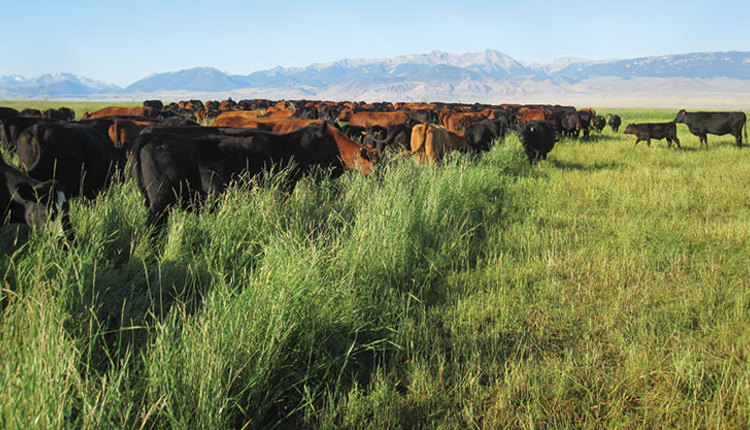Riding the big grass wave this spring |
| By Jim Gerrish |
|
|
The author is a rancher, author, speaker, and consultant with over 40 years of experience in grazing management research, outreach, and practice. He has lived and grazed livestock in hot, humid Missouri and cold, dry Idaho.  Can we do something to change this annual race toward overgrown, headed-out pastures? Yes, and it all starts with a better understanding of how grasses grow. Grasses differ Most cool-season grasses only produce seedheads during their first spring growth cycle. Tillers have to go through winter conditions (vernalization) to induce seedhead development. The signal for cool-season grasses to produce seedheads in spring is a longer day length (photoperiod). In contrast, warm-season grasses head and flower in response to accumulated heat units. It doesn’t really matter how relatively cool or warm the temperature has been for cool-season grasses. At any given latitude, grasses head at essentially the same time every year because the heading trigger is day length, not temperature. Once an individual tiller produces a seedhead, it is done. No new leaves are produced once the seedhead has appeared. Any new grazable forage growth comes from new tillers. Generally, those new tillers were initiated in spring and have not undergone vernalization, so they will not head out until the following year. No spring nitrogen With this basic understanding, we can come up with some strategies to reduce the likelihood of having overgrown, over mature pastures after just a month of growth. The first step is to not fertilize pastures in spring with nitrogen. For those producers still using spring nitrogen applications, all that does is accelerate and accentuate decline in the nutritive value of spring forage. If you are going to use nitrogen fertilizer, do not apply any until after 45 to 60 days of grazing. This will allow most of your applied nitrogen to support growth of new spring-initiated vegetative tillers rather than just growing stems and seeds. Rather than using nitrogen fertilizer at all, growing grass-legume mixtures is generally a lower-cost approach to pasture production. I generally suggest 30% to 40% of total forage production coming from legumes. Legumes tend to reach maturity at a later calendar date than do cool-season grasses. Also, legumes maintain a higher nutritive value later into maturity than do the grasses. The bottom line is that peak yield comes later for grass-legume mixtures compared to nitrogen-fertilized grass monocultures, so you have a longer window of time to effectively manage the spring flush of growth. Graze early and fast The grazing strategy we have used to minimize the effect of an explosive spring flush is to get across all of our pastures twice in the first 45 to 60 days of the growing season. We move our cattle every day and have been doing so for over 30 years. When we start our first grazing cycle of the spring on new growth, we will begin when grass is between the 2 and 3 leaf stage. We give fairly large areas and expect to make the first cycle in just 20 to 25 days. Utilization rate is low as we are just trying to get a bite off most plants. We slow down on the second cycle by giving smaller areas while taking 25 to 35 days to get around. Our objective on this cycle is to take a little deeper bite to remove elongating stems. When undeveloped seedheads are being elevated from the base of the plant, they are highly nutritious and palatable. As we make paddocks smaller and raise stock density, the likelihood of grazing stock removing undeveloped seedheads is high. New tillers arise Once the plant apical growth point has been removed, new tillers can be initiated, and those tillers will provide vegetative growth later in the growing season. We have used this approach successfully in both Missouri on high natural rainfall pastures and on irrigated pastures in Idaho. In Missouri, we dealt with a lot of endophyte-infected fescue, and this was a good approach to reduce fescue toxicity as well as the competitive advantage tall fescue is reputed to have. Through grazing management, we changed pastures that started with more than 80% fescue and reduced the fescue content to less than 30%. Natural species diversification followed, including numerous native warm-season grasses. In Idaho, with much later spring growth initiation due to our more northerly latitude and high elevation, the window of time from the beginning of growth to heading is much shorter. Fortunately, the cooler temperatures also preserve higher forage quality later into maturity, so we are still able to accomplish our objective of seedhead reduction. We just have to ask the cattle to eat some more mature forage by midway through the second grazing cycle. When using this strategy, we have been able to reduce seedhead production to just 10% to 20% of tillers that were vernalized over winter. I will emphasize that we do not use nitrogen fertilizer, and we try to maintain a strong legume component. The spring flush is manageable, you just need to have a plan. For more information visit www.americangrazinglands.com. This article appeared in the April/May 2020 issue of Hay & Forage Grower on pages 20 and 21. Not a subscriber? Click to get the print magazine. |
